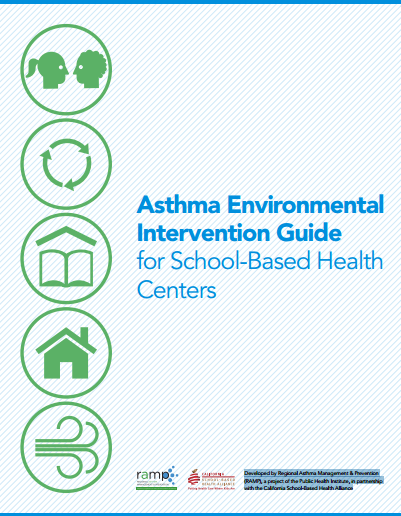
Asthma Environmental Intervention Guide for School-Based Health Centers
-
Focus Areas
Chronic Disease Prevention -
Issues
Asthma, School-based Efforts -
Programs
Regional Asthma Management and Prevention Program

 School-based health centers (SBHCs) and their staff are uniquely positioned to help children breathe easier by leading and supporting evidence-based strategies and promising practices to reduce exposure to environmental asthma triggers. While many SBHCs across the country are already playing a key role in helping students manage their asthma by providing quality clinical care and education, there is an opportunity for SBHCs to also be leaders in managing the environmental factors that make asthma worse.
School-based health centers (SBHCs) and their staff are uniquely positioned to help children breathe easier by leading and supporting evidence-based strategies and promising practices to reduce exposure to environmental asthma triggers. While many SBHCs across the country are already playing a key role in helping students manage their asthma by providing quality clinical care and education, there is an opportunity for SBHCs to also be leaders in managing the environmental factors that make asthma worse.
Download Asthma Environmental Intervention Guide for School-Based Health Centers. In order to help us evaluate the impact of this guide, we also ask you to take a brief survey.
Developed by Regional Asthma Management & Prevention (RAMP)—a project of the Public Health Institute—in partnership with the California School-Based Health Alliance, this guide describes the relationship between asthma and a number of environmental asthma triggers and shares scientific evidence that SBHC staff can cite when educating others on the need to address environmental asthma triggers. This is followed by five sections each tackling a strategy, or broad category of intervention, that SBHC staff could lead or support. They include:
- Education
- Case Management
- Improving Indoor Air Quality in Schools
- Improving the Students’ Home Environments
- Improving Outdoor Air Quality Around the School and Community
Each section provides an overview of the type of intervention, points to specific tools and resources, and suggests how SBHC staff can lead or support implementation. The array of interventions is intended to serve as a “menu” from which SBHC can choose depending on their interests, resources, and the particular needs of their patient population. While a comprehensive approach that works across settings and utilizes multiple strategies is likely most effective for reducing the burden of asthma, any step that SBHCs can take to reduce exposure to environmental asthma triggers will help students breathe easier.
Additional resources:
Originally published by Download
Work With Us
You change the world. We do the rest. Explore fiscal sponsorship at PHI.
Support Us
Together, we can accelerate our response to public health’s most critical issues.
Find Employment
Begin your career at the Public Health Institute.


